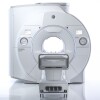SNMMI 2014: Therapy saves heart attack patients
by Lauren Dubinsky, Senior Reporter | June 13, 2014

Researchers at this year's Society of Nuclear Medicine and Molecular Imaging meeting revealed that a protein promotes the production of stem cells, that restores damaged heart tissues after myocardial infarction.
Utilizing molecular imaging, the researchers analyzed 40 consecutive patients with acute myocardial infarction after giving them either G-CSF therapy or saline intravenously for five days starting during a selected minimally invasive treatment. The patients underwent SPECT stress tests for one year and the researchers found that the earlier start of G-CSF therapy improves blood flow, access to vital energy and overall cardiac function.
In 2010, coronary heart disease was the culprit behind one out of every six fatalities in the U.S., and there are about 379,559 deaths each year, according to 2014 American Heart Association data.

 When granulocyte colony-stimulating factor (G-CSF) is given after a heart attack, it mobilizes bone marrow stem cells, which decreases the collateral damage of cell death that happens as a result of acute myocardial infarction. It has a better probability of working if it's administered early on in treatment.
When granulocyte colony-stimulating factor (G-CSF) is given after a heart attack, it mobilizes bone marrow stem cells, which decreases the collateral damage of cell death that happens as a result of acute myocardial infarction. It has a better probability of working if it's administered early on in treatment.
"Previous studies have shown that giving G-CSF to unselected heart attack patients failed to satisfactorily improve their condition, but G-CSF may potentially be beneficial if given earlier than 37 hours following myocardial infarction and coronary intervention," Dr. Takuji Toyama, the study's principal researcher from the division of cardiology at Gunma Prefectural Cardiovascular Center in Maebashi, Japan, said in a statement.
"This study shows that the first intravenous drip infusion of G-CSF during treatment just after hospitalization was able to rescue our patients," Toyama said. "I am confident that with additional data from a forthcoming clinical trial, this protocol can be adopted as a standard of practice."
Utilizing molecular imaging, the researchers analyzed 40 consecutive patients with acute myocardial infarction after giving them either G-CSF therapy or saline intravenously for five days starting during a selected minimally invasive treatment. The patients underwent SPECT stress tests for one year and the researchers found that the earlier start of G-CSF therapy improves blood flow, access to vital energy and overall cardiac function.
In 2010, coronary heart disease was the culprit behind one out of every six fatalities in the U.S., and there are about 379,559 deaths each year, according to 2014 American Heart Association data.
New Fully Configured 80-slice CT in 2 weeks with Software Upgrades for Life
For those who need to move fast and expand clinical capabilities -- and would love new equipment -- the uCT 550 Advance offers a new fully configured 80-slice CT in up to 2 weeks with routine maintenance and parts and Software Upgrades for Life™ included.

"Previous studies have shown that giving G-CSF to unselected heart attack patients failed to satisfactorily improve their condition, but G-CSF may potentially be beneficial if given earlier than 37 hours following myocardial infarction and coronary intervention," Dr. Takuji Toyama, the study's principal researcher from the division of cardiology at Gunma Prefectural Cardiovascular Center in Maebashi, Japan, said in a statement.
"This study shows that the first intravenous drip infusion of G-CSF during treatment just after hospitalization was able to rescue our patients," Toyama said. "I am confident that with additional data from a forthcoming clinical trial, this protocol can be adopted as a standard of practice."
You Must Be Logged In To Post A CommentRegisterRegistration is Free and Easy. Enjoy the benefits of The World's Leading New & Used Medical Equipment Marketplace. Register Now! |
|










